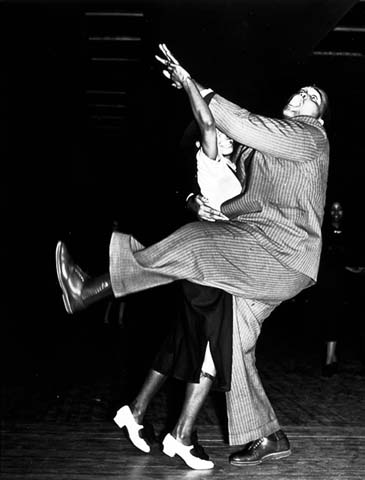Last night I did a blues set for the first time in a while, and it was the first time in ages that I feel I did a decent job. It was easier this time because we weren’t in the huge, high-ceilinged, cold room, but in a smaller, lower-ceilinged, darker room where the couches were right in there. I like an L-shaped room for this sort of thing, but only if the couches are in the little ‘leg’ of the L and the dancing in the main part. We also had a better sound system – one that used a proper mixer rather than just plugging straight into the speaker (!!!).
The space made a big difference to me, but it was even more important for the dancers, who could actually get into the songs emotionally. I saw a lot more movement with emotional commitment, or at least movement that was dancing rather than just moving about on the dance floor. There also seemed to be better communication between the partners, which was also nice to see. Once again there were too few leads, but this lead to lots of talking and fun-having by the women standing about on the side lines, which was a relief. But I’d still like to see more women leading to forestall this problem. Guess we need some good role modelling, huh?
Speaking of role modelling, in this post I’m going to explore the themes of the lyrics and delivery of the songs I played, as well as how they worked in the room. They are all pretty hardcore, politically speaking.
Here’s the set I played:
Friday 6 May 2011, 9.50-10:50
I’m Feeling Alright – Big Mama Thornton – Ball N’ Chain – 111 – 1968 – 3:00
Sleep in Late – Molly Johnson – Another Day – 87 – 2002 – 2:48
Built for Comfort – Taj Mahal In Progress & In Motion (1965-1998) – 98 – 1998 – 4:46
Ballin’ the Jack – Mona’s Hot Four (Dennis Lichtman, Gordon Webster, Cassidy Holden, Nick Russo, Jesse Selengut, Dan Levinson) – Live at Mona’s – 111 – 2009 – 5:27
Reckless Blues – Louis Armstrong and his All Stars (Velma Middleton, Trummy Young Edmund Hall, Billy Kyle, Everett Barksdale, Squire Gersh, Barrett Deems) – The Complete Decca Studio Recordings of Louis Armstrong and the All Stars (disc 06) – 88 – 1957 – 2:30
Come Easy Go Easy – Rosetta Howard acc. by the Harlem Blues Serenaders (Charlie Shavers, Buster Bailey, Lil Armstrong, Ulysses Livingston, Wellman Brand, O’Neil Spencer) – Rosetta Howard (1939-1947) – 90 – 1939 – 3:03
Moaning The Blues – Victoria Spivey acc by Henry ‘Red’ Allen, JC Higginbotham, Teddy Hill, Luis Russell – Henry Red Allen And His New York Orchestra (disc 1) – 97 – 1929 – 3:07
I Ain’t No Ice Man – Cow Cow Davenport with Joe Bishop, Sam Price, Teddy Bunn, Richard Fullbright – History of the Blues (disc 02) – 89 – 1938 – 2:51
Amtrak Blues – Alberta Hunter (acc by Doc Cheatham, Vic Dickenson, Fran Wess, Norris Turney, Billy Butler, Gerald Cook, Aaron Bell, Jackie Williams) – Amtrak Blues – 95 – 1978 – 3:24
Back Water Blues – Belford Hendricks’ Orchestra with Dinah Washington – Ultimate Dinah Washington – 71 – 1957 – 4:58
Cherry Red – Big Joe Turner, Joe Newman, Lawrence Brown, Pete Brown, Frank Wess, Pete Johnson, Freddie Green, Walter Page, Cliff Leeman – The Boss Of The Blues – 96 – 1956 – 3:25
Sweet Home Chicago – David “Honeyboy” Edwards – Sun Records – The Blues Years, 1950 – 1958 CD4 – 112 – 3:01
Knock on wood – Ike And Tina Turner – The Ike & Tina Turner Archive Series : Hits & Classics Vol.1 – 119 – 1998 – 2:31
Hound Dog – Big Mama Thornton – Very Best Of – 76 – 2:52
Backlash Blues – Nina Simone – Nina Simone Sings the Blues – 78 – 1967 – 2:32
Things are Slow – Barbara Dane – I Hate the Capitalist System – 91 – 4:173 O’clock In The Morning Blues – Ike and Tina Turner Putumayo Presents: Mississippi Blues – 64 – 1969 – 2:40
Sugar Blues – Preservation Hall – The Hurricane Sessions – 61 – 2007 – 5:02
I came in with that Big Mama Thornton song because it usually works: loud, high energy, lots of fun, hi-fi. But that wasn’t quite right in this darker, more mellow room. I was a bit nervy, though, and felt a bit out of practice, so I went with something I’d tried before.
Followed up with Molly Johnson because it’s a good change. It went down a lot better than the Thornton, but I still wasn’t happy. The floor filled up, though.
Taj Mahal after that, and that worked well. Though it still felt a bit loud and shouty, it did go down quite well. I do like the way he’s singing about being built for comfort, not speed:
Some folks built like this,
Built like that,
Don’t you howl at me, don’t you call me fat!
You know I’m built for comfort, I ain’t built for speed.
Oh, sweet papa Earl, got everything sweet mama need.
Then a song by Mona’s Hot Four, which I adore. It went down surprisingly well for something which is quite long, quite emotionally intense (though not as serious as some). It was nice to move towards a banjo/piano/group impro sound. Also, I really dig that Gordon Webster (piano)/Jesse Selengut (vocal) combination. ‘Balling the Jack’ is a dance, but it’s also a sexual euphemism.
Because people seemed to be ok with the more serious, intense sound, I decided to slow it down and head towards some saucier, slower old school stuff. This Armstrong modern All Star stuff is good for that. I overplay this song in blues, which is kind of ok because there really isn’t a repertoire of ‘favourites’ or ‘overplayed’ songs in Sydney blues yet. I think dancers need something familiar when they’re only beginning to get into social dancing, and the Sydney blues scene is really only just finding its feet again. Reckless Blues is sung by a woman, about being a woman who takes risks. Romantic/sexual ones by implication (and the feel of the music), but the broader theme is that this is a woman who does as she likes.
Then Rosetta Howard. This is where I really wanted to be. I don’t get to play this sort of scratchy blues here in Sydney much, mostly because we tend to use venues with fucked up sound systems. But this is my blues dancing and DJing happy place. Check out the band in that song. Wowsers!
‘Come Easy Go Easy’ is about having money that comes easy, goes easy – spending money freely, whether it’s your own or your man’s.
Then, finally, I get to play Moanin The Blues for dancers! Best song ever! Of all time! It went down a treat, which was very nice. It is, of course, about a man who’s no good, and gets a good telling off. But it’s also a song about sex. And being really good at it.
Now you talk about the black snake blues,
Well you haven’t heard no moanin’ yet,
ooohhh yeah
aaaall day long
And when you hear this moanin’,
This moanin you will never forget.aaaaiiiii oooo
mmmmm- mmmmmm
(moaning)
Well I know I can moan,
I don’t see how I lost my happy home.Well it was on a Sunday mornin’,
I didn’t feel so good
I felt like a cow when she has lost her cud,
I began a moanin’
all day long.And when you hear me a moanin’
You can bet sweet mama feel good.aaaaiiiii oooo
mmmmm- mmmmmm
(moaning)
Lord I know I can moan,
I don’t see how I lost my home.Well I’m the only one in my family
to take a biscuit to pieces
put back just how it was,
Oh, when I’m moanin’,
all day long.
Yes, I can kick my leg high,
and you oughtta see me do the bug.aaaaiiiii oooo
mmmmm- mmmmmm
(moaning)
After that I had a feeling the dancers had kind of used up their scratch song skills, and would need a change of pace. So I played this last one (I Ain’t No Ice Man), and had considered following up with Butterbeans and Susie then going to C W Stoneking’s duet stuff, but aborted at the last minute. That Stoneking stuff really isn’t very good, and it would look particularly bad next to the Butterbeans and Susie stuff, which is very good.
The lyrics to this song are fairly standard blokey bravado about sexual prowess, but in this context, where I’m focussing on women vocalists and women’s feelings about sex and men, it changes the implication. Less all about men, and just one man’s contribution to a wider discussion about sex:
I ain’t no iceman,
I ain’t no iceman’s son
I ain’t no iceman,
I ain’t no iceman’s son,
but I can keep you cool
until the iceman comesI ain’t no woodchopper,
I ain’t not woodchopper’s son,
I ain’t no woodchopper,
I ain’t not woodchopper’s son,
but babe, I can chop your kindlin,
until the woodchopper comes.Baby, I ain’t no stoveman,
I ain’ no stoveman’s son,
Baby, I ain’t no stoveman,
I ain’ no stoveman’s son,
but I can keep you heated up,
baby til the stoveman comes.Baby, I ain’t no butcher,
and I ain’t no butcher’s son,
I ain’t no butcher,
I ain’t no butcher’s son,
But I can promise you plenty a meat,
baby til the butcher comes.I ain’t no milkman,
I ain’t no milkman’s son,
I ain’t no milkman,
I ain’t no milkman’s son,
But I can promise you plenty a cream,
baby til that milkman comes.
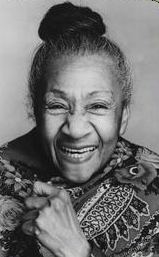
So I changed it up completely. Sort of. Alberta Hunter is a good transition because she was there in the 20s, singing that sort of old school blues, so her delivery is just right – a mix of extremely dirty and sly humour. But this is a hi-fi song with a bit of a grooving feel. It also feels like the song wants you to move around the floor. Which is appropriate, considering it’s about the Amtrak rail. But that’s a contrast to the previous few songs, which make me feel like standing on the spot working some action.
Amtrak Blues is about a woman whose man has left her, and who’s feeling really bad….mostly:
Some body come here and help me
help me, cause the man I love is gone,
Some body come here and help me
help me, cause the man I love is gone,
I’m so confused and worried,
I can hardly carry on.Trouble and dark days,
Can’t last always,
So I’ll keep on strugglin’,
I know I’ll see brighter days
(aside: please help me, somebody! Help me!)My two sisters told me
other people tried to tell me too
(oh lord, yes)
I said my sisters told meOh, they said
You don’t change your way of living,
that very man’s gonna be the death of you.I know he’s ornery, he’s selfish
He’s the type of man that just don’t care,
I know he’s ornery, he’s selfish
he’s the type of man that just don’t care
oh, he’d pawn the holy bible, just to get his Amtrak fare,I love him, yes I love him
Oh I love him, and I don’t mind dying
I love him, yes I love him
love him, and I don’t mind dying,I ever run across him,
Gonna crack his head and drink his blood like wine
In typical Hunter style, if she ends up finding the man who’s left her, she’ll have her revenge. The song is really good because Hunter adds lots of ‘help me, help me’, and ‘oh lord, lord, help me!’ so you really feel her suffering. The tension builds, until the final line, which is perhaps doubt a Hunter addition. But the musical tone is a bit higher energy – this isn’t a slow, dragging dirge. We feel her suffering, but then the final line tips it all on its head, and we realise it was actually a song about how horrid he is, so that we feel for her, and when, in the final, climactic moment, she declares she’ll break his head and drink his blood like wine, we want to yell out “YES!”
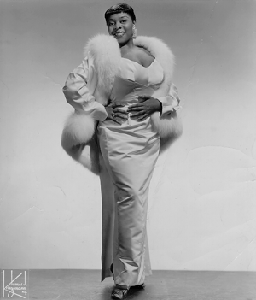
Back Water Blues was perhaps not quite right here. I think I was too deep in my headphones and previewing to properly judge the mood in the room. But people were into the hi-fi, the more modern sound, and they were ok with the more intense feeling of the song. This picture of Dinah Washington is perhaps the least appropriate possible for this song, but it’s a great pic…
Back Water Blues is a Bessie Smith song, about the flooding in the south, and how it affected the poor and black folk of the area. There are quite a few songs about flooding, and they really took on greater significance after Hurricane Katrina: things hadn’t changed much in a hundred years. This one really is a sad song, despairing. It’s a woman singing about the awful things that have happened to her:
When it rains five days
and the skies turn dark as night,
When it rains five days
and the skies turn dark as night,
Then trouble’s takin’ place
in the lowlands at night.I woke up this mornin’,
can’t even get out of my door,
I woke up this mornin’,
can’t even get out of my door,
There’s been enough trouble
to make a poor girl wonder where she want to go.Then they rowed a little boat
‘Bout five miles ‘cross the pond,
Then they rowed a little boat
‘Bout five miles ‘cross the pond,
I packed all my clothes,
throwed them in
and they rowed me along.When it thunders and lightnin’,
and when the wind begins to blow,
When it thunders and lightnin’,
and when the wind begins to blow,
There’s thousands of people
ain’t got no place to go.Then I went and stood upon
some high old lonesome hill,
Then I went and stood upon
some high old lonesome hill,
Then looked down on the house,
were I used to live.Backwater blues
done call me to pack my things and go,
Backwater blues
done call me to pack my things and go,
‘Cause my house fell down
and I can’t live there no more.Mmm, I can’t move no more
Mmm, I can’t move no more
There ain’t no place for a poor old girl to go
Then I played that neat version of Cherry Red, which I should have played after Amtrak Blues. Same ‘moving’ feeling, a little higher tempo, hi-fi. Brilliant musicians: Big Joe Turner, Walter Page, Freddie Green, Pete Johnson, etc. I like the way Turner invites his woman:
Now you can take me,
Pretty mama,
Jump me in your Hollywood bed,
And eagle rock me baby
‘Til my face turns cherry red.
The eagle rock is a dance step, but I like the way it also works as a metaphor here. And I like it that he’s inviting a woman to take him; he’s inviting a (sexually) assertive woman.
Anyway, that song went down really well.
Then I changed it up again with that version of Sweet Home Chicago, which has a nice guitar sound, and again, that walking feeling. It’s a familiar song, but not a version most people would hear. I like the way the vocals match Joe Turner’s: big, shouty, kind of intense.
By now people were kind of getting tired. So I chucked in Knock On Wood to change things up. I love early Ike and Tina Turner. Tina’s shouting matches the previous two. I could perhaps have gone with something a little less soul and a little more blues from their repertoire, but this one has the familiarity factor. It went down well, upped the energy in the room, and got all the women standing about up and dancing together.
Hound Dog. Even I’m a bit sick of this. But it’s a good transition. More shouting women. This time, a bit slower, and more in that proper blues vein.

Backlash Blues, because this is a good transition from soul to blues. It has that same walking feeling. I almost went straight to this from Knock on Wood. I think I should have. But it’s a bit lower energy than Hound Dog, so we would have dropped down too quickly. And I wanted just a bit more fun/familiar/energy stuff before I switched gears down to more intense, slower blues.
I also love this song because it’s hardcore 60s politics. I remember some guy in Melbourne once telling me that this song isn’t political at all. Dickhead. I mean, a) Nina Simone, hardcore activist, and b), the title – Backlash Blues! Here are the lyrics (which I think were co-written with Langston Hughes, or at least borrowing his lyrics):
Mr. Backlash, Mr. Backlash
Just who do think I am
You raise my taxes, freeze my wages
And send my son to VietnamYou give me second class houses
And second class schools
Do you think that alla colored folks
Are just second class fools
Mr. Backlash, I’m gonna leave you
With the backlash bluesWhen I try to find a job
To earn a little cash
All you got to offer
Is your mean old white backlash
But the world is big
Big and bright and round
And it’s full of folks like me
Who are black, yellow, beige and brown
Mr. Backlash, I’m gonna leave you
With the backlash bluesMr. Backlash, Mr. Backlash
Just what do you think I got to lose
I’m gonna leave you
With the backlash blues
You’re the one will have the blues
Not me, just wait and see

Then something new for me – Barabara Dane, singing seriously hardcore 60s politics. I LOVE her voice, and play one of her songs for lindy hoppers a lot (with Lu Watters’ Yerba Buena Jazz Band). This song from the album ‘I Hate the Capitalist System’ is a perfect transition from Backlash Blues. Almost exactly the same rhythm/beat, but a bit lighter and more humorous with some cool organ action in there. It’s a proper blues song, with serious politics, but also that 60s folk music politics. And Dane’s voice. YES. This song went down really, really well, which is very pleasing, as I like it a lot.
Then some slower, more intense Ike and Tina Turner, because I wanted to bring it down a bit again. And then I closed with Sugar Blues, which is slower, and quite intense, but a bit funny as well, so the next DJ could go anywhere, really.
Overall, it was a fun set. It’s a pleasure playing blues, because the music can be so subversive. Women singing about sex, men singing about finding assertive women attractive, labour politics, race politics, being poor, being angry, the effects of flooding on the poor…. It’s the sort of stuff that blues music does well. It’s the emotional balance to swing, which is all about partying. Blues songs are about feeling shit, and then singing a song (and telling a story) to share your feelings, garner support from your friends, and then stomp those blues til you feel better.

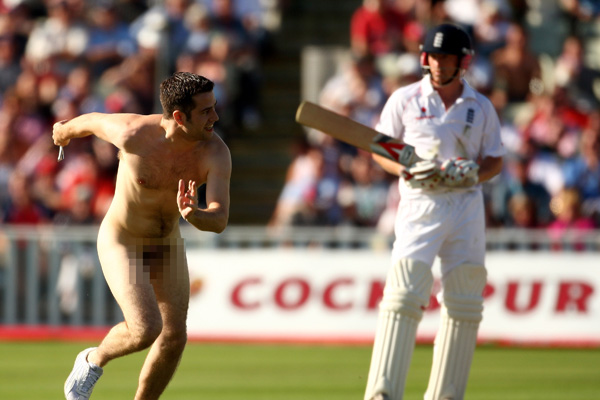
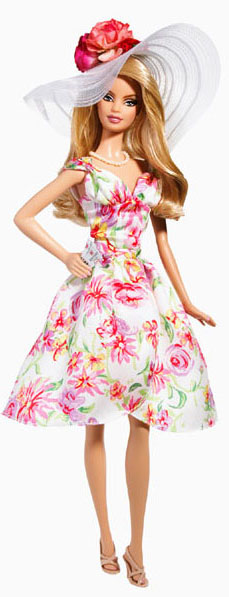
 6. And finally, an historical argument. Women lindy hoppers today should wear high heeled shoes, because that’s what women lindy hoppers wore then? Hm. I call bullshit, again.
6. And finally, an historical argument. Women lindy hoppers today should wear high heeled shoes, because that’s what women lindy hoppers wore then? Hm. I call bullshit, again.